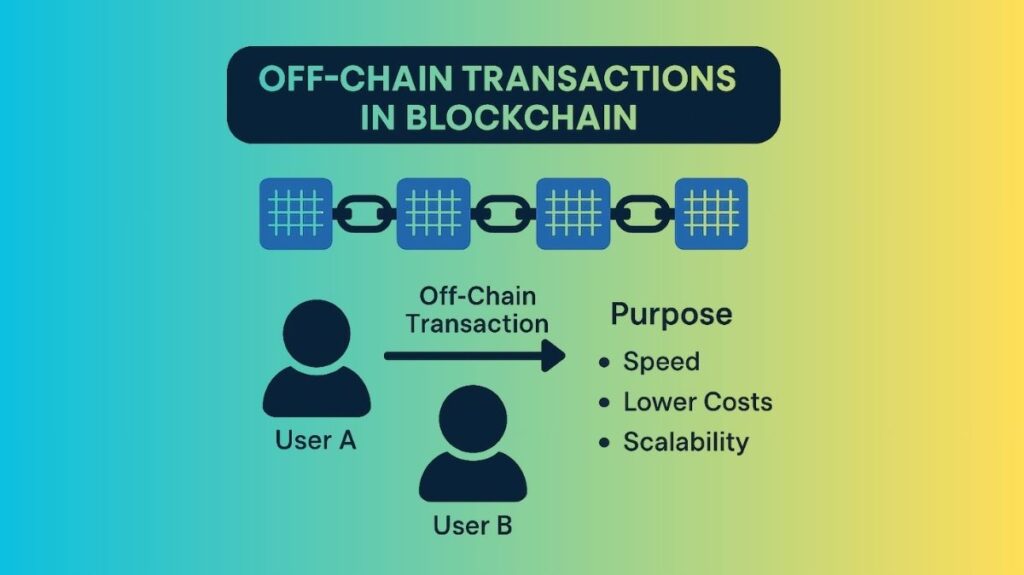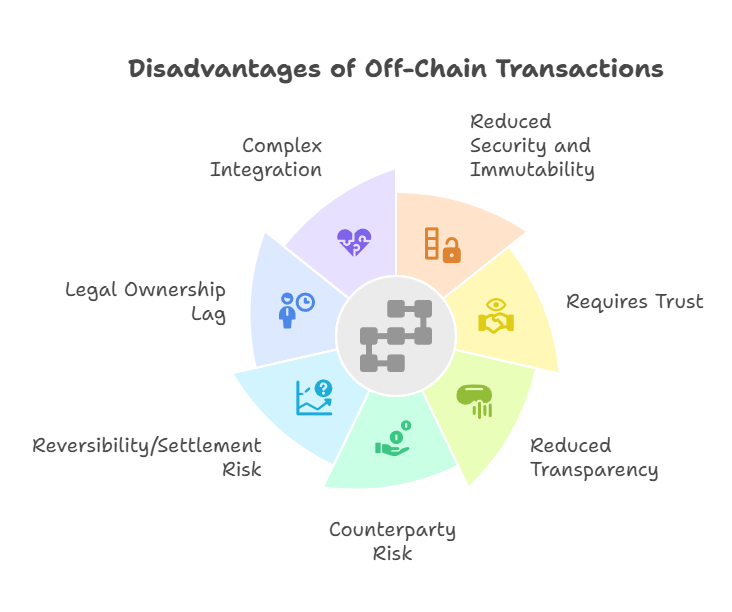Off Chain Transactions

Off chain transactions refer to operations or transactions that take place outside of the main blockchain network. Instead of being directly recorded on the primary blockchain, these transactions are processed and managed in separate systems or networks, with only their final states or summaries eventually being settled on the main chain.
Purpose and Benefits
- Scalability and Performance: Blockchains, particularly public ones like Bitcoin and Ethereum, often face limitations in transaction processing speed and volume due to their design, where every node must process and validate every transaction. Off-chain solutions, often called “Layer 2” solutions, alleviate this by moving a significant number of transactions off the main chain, enabling much faster processing times and higher throughput.
- Cost Efficiency: By reducing the need for every single transaction to be recorded on the main blockchain, off-chain methods can significantly lower transaction fees, which can become prohibitively expensive during network congestion.
- Privacy: Since the granular details of every off-chain transaction are not broadcast to the entire public blockchain, these methods can offer enhanced privacy and confidentiality for participants. Some techniques, like privacy managers, are specifically designed for this purpose.
- Improved User Experience: Off-chain processing can simplify the user experience by reducing complexity. Users may not need to constantly manage gas fees or directly interact with the intricacies of the blockchain network for every minor action.
- Enabling New Models: They facilitate microtransactions and frequent interactions that would otherwise be impractical or too costly to perform directly on the main chain, opening up new business models and applications.
You can also read What is Distributed Hash Table Blockchain And How it works
Disadvantages of Off-Chain Transactions:

Disadvantages of Off-Chain Transactions
- Reduced Security and Immutability: Since they are not secured by the main blockchain, they may lack its inherent security and immutability. This can lead to concerns about data integrity and trustworthiness.
- Requires Trust: Off-chain solutions often necessitate trust in the intermediary (e.g., a centralized exchange) or the specific off-chain system, which can compromise the decentralized nature of blockchain.
- Reduced Transparency: It can be harder for external parties to verify what happened off-chain.
- Counterparty Risk: Users must trust the parties that created the off-chain solution or the counterparties in a direct agreement.
- Reversibility/Settlement Risk: Some off-chain transactions may be irreversible, making dispute resolution more difficult. If not eventually settled on-chain, disputes may arise.
- Legal Ownership Lag: While ownership is transferred off-chain, it’s not updated on the blockchain until broadcast, which could be exploited if not accounted for.
- Complex Integration: Integrating off-chain data with on-chain elements can be complex, requiring careful design.
Advantages and Disadvantages
| Feature | Advantages of Off-Chain | Disadvantages of Off-Chain |
| Speed | Transactions are instantaneous. | The initial and final settlement transactions on the main chain can still be slow. |
| Cost | Virtually no fees for individual transactions. | The initial and final on-chain transactions incur fees. |
| Scalability | Allows for a massive increase in transaction throughput. | Can still face scalability issues if not designed properly. |
| Privacy | Individual transactions are not publicly broadcast on the main ledger. | Some solutions, especially centralized ones, can compromise privacy and introduce counterparty risk. |
| Security | Inherits the security of the main blockchain, but can introduce some risks. | Relies on the security of the off-chain layer, which may be less secure or battle-tested than the mainnet. |
| Decentralization | Can still be decentralized (e.g., Lightning Network). | Can rely on a trusted third party (e.g., CEX) or a limited set of validators (e.g., some sidechains), which introduces centralization. |
You can also read On-Chain Transactions: The Core Of Blockchain Functionality
How They Work (Common Mechanisms)
Off-chain solutions are typically referred to as “Layer 2” solutions, built on top of the “Layer 1” main blockchain.
- State Channels: This involves two or more parties opening a direct “channel” or mini-ledger off-chain. They can conduct an unlimited number of transactions within this channel quickly and cheaply, without each transaction being broadcast to the main blockchain. Only the initial funding of the channel and the final, net result of all interactions are recorded on the main chain when the channel is closed or synchronized. Bitcoin’s Lightning Network and Ethereum’s Raiden Network are prominent examples of state channels.
- Sidechains are separate, alternative blockchain networks that are “bridged” or cryptographically “pegged” to the main blockchain. Moving assets between the main chain and the sidechain is possible. Different consensus techniques may be used by sidechains, which could enable cheaper or quicker transaction rates than the main chain. One kind of sidechain is called a plasma chain, in which the security is improved by allowing cryptographic proofs on the main chain, which can enforce proper behavior even if the sidechain validators cheat.
- Layer 2 solutions known as rollups carry out transactions off-chain, but they “roll up” or bundle a large number of these transactions into a single, compressed transaction that is subsequently uploaded to the main chain. This makes it possible for transaction throughput to rise significantly. Zero-Knowledge (ZK) rollups and optimistic rollups are two examples.
- With meta-transactions, a user can sign a transaction off-chain, and a third party (referred to as a “relayer”) will pay the gas fees to submit the transaction on-chain. This streamlines user onboarding by removing the need to store cryptocurrency for gas from the user’s intention to transact.
- Privacy managers are off-chain components that manage transaction secrecy in permissioned or business blockchains (like Quorum). By substituting a hash on the main chain for the actual transaction data, they make sure that only authorized users may access the encrypted payload off-chain.
Relationship to On-chain Transactions
The primary layer of security and trust for off-chain solutions is the main blockchain (Layer 1). Channel opening and closing, and transaction batch summarization are committed to the main chain after much off-chain activity. This ensures that off-chain processes use the blockchain’s tamper-resistance and immutability without overwhelming it with transactions.
You can also read Web Wallet: Your Browser Based Cryptocurrency Solution
